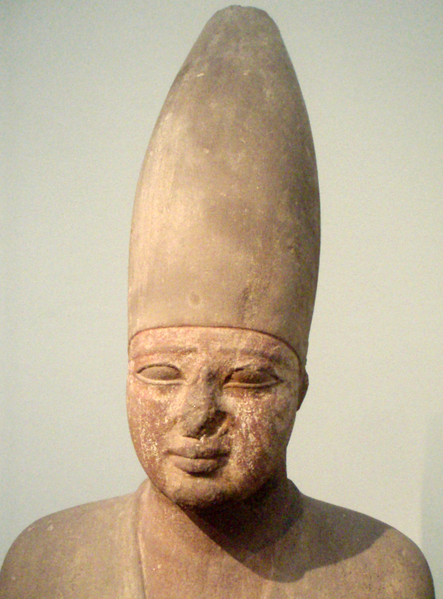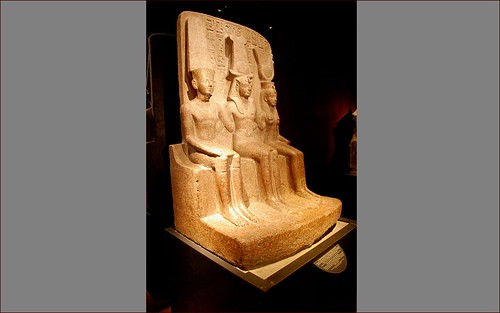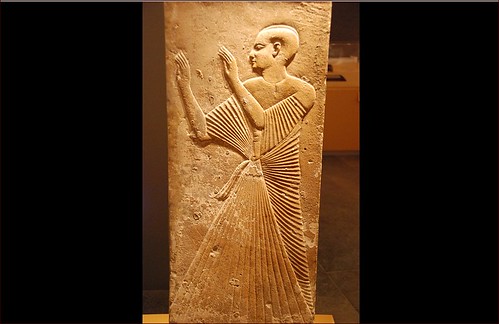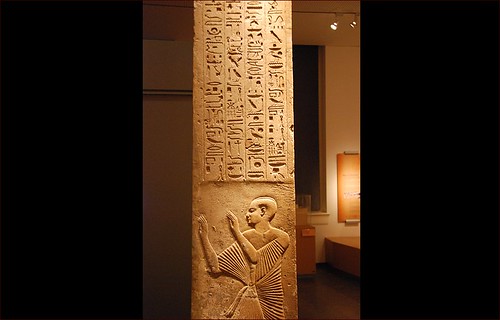Mentuhotep III
De Wikipedia, la enciclopedia libre
Sanjkara Mentuhotep, o Mentuhotep III, el sexto faraón de la dinastía XI de Egipto; gobernó unos doce años, de c. 1995 a 1983 a. C. (von Beckerath), durante el denominado Imperio Medio de Egipto.
Fue "el mayor de los hijos del rey" según reza una inscripción del mausoleo de su padre Mentuhotep II y sucedió en el trono a éste a edad avanzada, debido al prolongado reinado de su progenitor. Residió en Tebas, la capital del reino.
Heredó un país próspero y continuó con el amplio programa de construcciones de su predecesor, erigiendo templos para Amón y Montu, dioses locales que alcanzaron celebridad durante el primer periodo intermedio de Egipto.
Consolidó las fronteras del reino ordenando construir en la frontera nordeste de Egipto una serie de fortificaciones destinadas a proteger el valle del Nilo de las incursiones de los pueblos asiáticos.
Mentuhotep III organizó una expedición naval a la "Tierra de Punt" para obtener mercancías exóticas, que partió de la ciudad de Coptos con una escolta de 3.000 hombres armados. También envió expediciones a las minas de Uadi Hammamat, al mando de Henenu.
Comenzó a construir su tumba en el Deir el-Bahari, cerca de la tumba de su padre, pero nunca fue acabada. Probablemente fue enterrado en Tebas.
Contenido[ocultar] |
Testimonios de su época [editar]
Edificaciones:
- Continuó las construcciones iniciadas en época de su padre en Tebas, El-Kab, Armant, Tod, y Elefantina.
El nombre del rey se encuentra inscrito en:
- El templo de Amón, en Tebas
- El edificio del templo de Montu, en Tod
- Rocas del Uadi Hammamat
- Como parte de una fórmula de ofrendas en una estatua adquirida en Jatana, UC15516 (Museo Petrie)
Titulatura [editar]
| Titulatura | Jeroglífico | Transliteración (transcripción) - traducción - (procedencia) |
| Nombre de Horus: |
| s ˁnḫ t3uy.f (Seanjtauef) El que vivifica las Dos Tierras (Egipto) (J.J. Clére, J. Vandier, 1948, X, 34) |
| Nombre de Nebty: |
| s ˁnḫ t3uy.f (Seanjtauef) El que vivifica las Dos Tierras (J.J. Clére, J. Vandier, 1948, X, 34) |
| Nombre de Hor-Nub: |
| ḥtp (Hetep) Está en paz (J.J. Clére, J. Vandier, 1948, X, 34) |
| Nombre de Nesut-Bity: |
| s ˁnḫ k3 rˁ (Seanjkara) El que vivifica el espíritu (Ka) de Ra (L R Abidos nº 58) (L R Saqqara nº 45) |
| Nombre de Nesut-Bity: |
| s ˁnḫ k3... (Seanjka...) El que vivifica el espíritu... (Canon Real de Turín 5.17) |
| Nombre de Nesut-Bity: |
| s nfr k3 rˁ (Seneferkara) Hermoso es el Ka de Ra (Sala de antepasados de Karnak) |
| Nombre de Sa-Ra: |
| mn ṯ u ḥtp (Mentuhotep) Montu está satisfecho (J.J. Clére, J. Vandier, 1948, X, 34) |
Referencias [editar]
- Referencias digitales
- http://www.digitalegypt.ucl.ac.uk//chronology/mentuhotepIII.html (en inglés)
- Mentuhotep III (en inglés)
Enlaces externos [editar]
 Wikimedia Commons alberga contenido multimedia sobre Mentuhotep III. Commons
Wikimedia Commons alberga contenido multimedia sobre Mentuhotep III. Commons
| Predecesor: Mentuhotep II | Faraón Dinastía XI | Sucesor: Mentuhotep IV |
Mentuhotep III
From Wikipedia, the free encyclopedia
| Mentuhotep III | ||||
|---|---|---|---|---|
 | ||||
| Osiride statue of the 11th dynasty pharaoh Mentuhotep III, on display at the Museum of Fine Arts, Boston. | ||||
| Pharaoh of Egypt | ||||
| Reign | 2010 BC – 1998 BC, 11th dynasty | |||
| Predecessor | Mentuhotep II | |||
| Successor | Mentuhotep IV | |||
| Died | 1998 BC | |||
Sankhkare Mentuhotep III or Mentohotep III[3]Eleventh dynasty was Pharaoh of Egypt during the Middle Kingdom. He continued the building program of his father Mentuhotep II, erecting temples to among others, Amun and Montu, local godsFirst Intermediate Period. He was assigned a reign of 12 years in the Turin Canon. of the who had grown in prominence during the
[edit]References
- ^ King List (chronological)
- ^ Clayton, Peter A. Chronicle of the Pharaohs: The Reign-by-Reign Record of the Rulers and Dynasties of Ancient Egypt. Thames & Hudson. p72. 2006. ISBN 0-500-28628-0
- ^ Firth, Lesley (editor-in-chief) et al (1985). "Mentohotep III". Who Were They? The Simon & Schuster Color Illustrated Question & Answer Book. Little Simon Book, Simon & Schuster, Inc., New York City, ISBN 0671604767., page 12.
[edit] Further reading
- W. Grajetzki, The Middle Kingdom of Ancient Egypt: History,Archaeology and Society, Duckworth, London 2006 ISBN 0-7156-3435-6, 23-25
[edit] External links
| Preceded by Mentuhotep II | Pharaoh of Egypt Eleventh Dynasty | Succeeded by Mentuhotep IV |
related articles
- TT280
- Meketre
- Mentuhotep IV
- Treasurer (Ancient Egypt)
- Neferkare, ninth dynasty
- Abydos King List
- Djedkare Shemai
- Neferkare Tereru
- Hannu
- Televise
En otros idiomas
- Català
- Česky
- Deutsch
- English
- Euskara
- Français
- Hrvatski
- Italiano
- 한국어
- Lietuvių
- Nederlands
- Polski
- Русский
- Srpskohrvatski / Српскохрватски
- Svenska
- Tagalog
- Tiếng Việt
> Si de relieves se habla a mí me fascina este
saludos cordiales
Mariela Taibo
Montevideo Uruguay
_________________________________________________________________
Windows Live Messenger GRATIS: lo que faltaba en tu BlackBerry. Clic Aquí
http://www.messengerentublackberry.com?ocid=WL_BB_LandPage_TagLine
##########################################
RSS Feed de Amigos de la Egiptología
http://www.egiptologia.com/index.php?format=feed&TYPE=rss
##########################################
Noticias y Actualidad Egiptológica
http://www.egiptologia.com/noticias.html
Recomendamos: Sociedad Catalana de Egiptología
http://www.egiptologia.com/societat-catalana-de-egiptologia.html
--------------------------------------------------------------
LISTA DE DISTRIBUCIÓN DE AMIGOS DE LA EGIPTOLOGÍA - AE
Gestión Altas-Bajas y consulta mensajes enviados:
http://www.egiptologia.com/lista-de-distribucion.html
Moderador: Víctor Rivas egiptologia@egiptologia.com
Amigos de la Egiptología: http://www.egiptologia.com
Los mensajes de Amigos de la Egiptología son distribuidos gracias al apoyo y colaboración técnica de RedIRIS Red Académica Española - http://www.rediris.es

Cargado el 5 de noviembre, 2009
Galería de Hans Ollermann
King Ramses II (also called Ramses the Great) 1279-1212 B.C.
2008_0610_143120AA Egyptian Museum, Turin

Ramses II is seated with Amun and his consort Mut, both considered as protectors of the Royal Family of the Lands of Egypt. His Majesty wears the Atef crown that is composed of the sundisk and ram horns with feathers of Justice.
Egyptian Museum, Turin.
2008_0610_143221AA Egyptian Museum, Turin

Ramses II is seated with Amun and his consort Mut, both considered as protectors of the Royal Family of the Lands of Egypt. His Majesty wears the Atef crown that is composed of the sundisk and ram horns with feathers of Justice.
Egyptian Museum, Turin.
2008_0610_143313AA Egyptian Museum, Turin

Ramses II is seated with Amun and his consort Mut, both considered as protectors of the Royal Family of the Lands of Egypt. His Majesty wears the Atef crown that is composed of the sundisk and ram horns with feathers of Justice.
Egyptian Museum, Turin.
2008_0605_150724AA

He lived during the reign of Pharaoh Ramses II in Memphis.
Limestone.
Dynasty 19, circa 1250 B.C.
Rijksmuseum voor Oudheden, Leiden, The Netherlands.

says:
Here an overview:

And here you see one of the statues, found in the tomb of Ptahmes, also now in the Rijksmuseum van Oudheden, Leiden:

Tomb statues of Ptahmes.
Ptahmes lived during the reign of pharaoh Ramses II.
He was chief steward in the Temple of Ptah in Memphis.
Ptahmes built his tomb in the desert of Saqqara.
Limestone.
From Saqqara.
19th dynasty, ca. 1250 B.C.
Rijksmuseum van Oudheden (State Museum of Antiquities), Leiden, The Netherlands.
2008_0605_150720AA

He lived during the reign of Pharaoh Ramses II in Memphis.
Limestone.
Dynasty 19, circa 1250 B.C.
Rijksmuseum voor Oudheden, Leiden, The Netherlands.












![N35 [n] n](http://es.wikipedia.org/w/extensions/wikihiero/img/hiero_N35.png)


![F35 [nfr] nfr](http://es.wikipedia.org/w/extensions/wikihiero/img/hiero_F35.png)



![G43 [w] w](http://es.wikipedia.org/w/extensions/wikihiero/img/hiero_G43.png)
![X1 [t] t](http://es.wikipedia.org/w/extensions/wikihiero/img/hiero_X1.png)
![Q3 [p] p](http://es.wikipedia.org/w/extensions/wikihiero/img/hiero_Q3.png)


![N5 [ra] ra](http://en.wikipedia.org/w/extensions/wikihiero/img/hiero_N5.png)
![S29 [s] s](http://en.wikipedia.org/w/extensions/wikihiero/img/hiero_S29.png)



![Y5 [mn] mn](http://en.wikipedia.org/w/extensions/wikihiero/img/hiero_Y5.png)
![N35 [n] n](http://en.wikipedia.org/w/extensions/wikihiero/img/hiero_N35.png)
![V13 [T] T](http://en.wikipedia.org/w/extensions/wikihiero/img/hiero_V13.png)
![G43 [w] w](http://en.wikipedia.org/w/extensions/wikihiero/img/hiero_G43.png)
![R4 [Htp] Htp](http://en.wikipedia.org/w/extensions/wikihiero/img/hiero_R4.png)
![X1 [t] t](http://en.wikipedia.org/w/extensions/wikihiero/img/hiero_X1.png)
![Q3 [p] p](http://en.wikipedia.org/w/extensions/wikihiero/img/hiero_Q3.png)


No hay comentarios:
Publicar un comentario